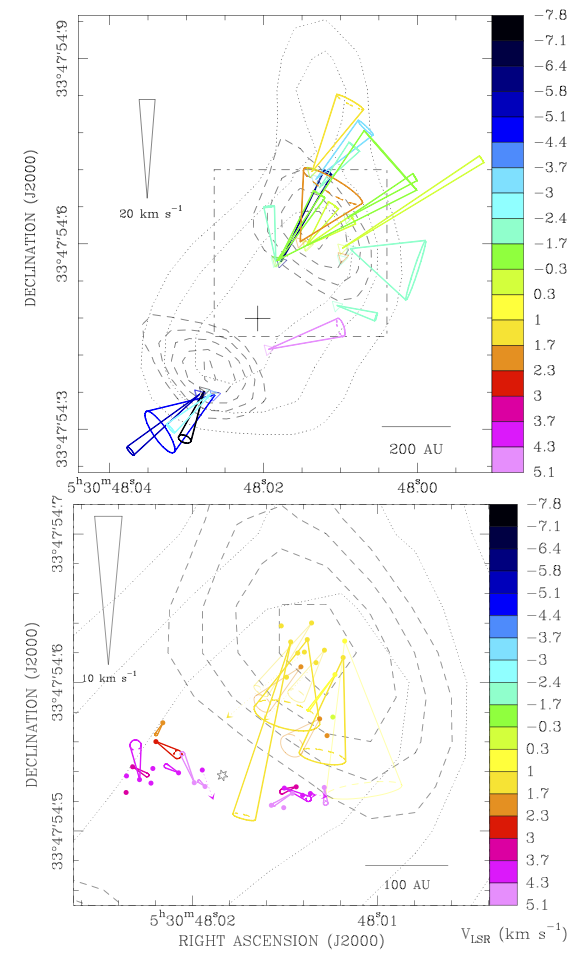Paper title: Infall and outflow within 400 AU from a high-mass protostar
Authors: C. Goddi, L. Moscadelli, and A. Sanna
First author’s affiliation: European Southern Observatory, Germany

Cartoon of star formation, presented by Shu et al. (1987). Goddi et al. (2011) confirm the infall and outflow shown here.
Introduction: The common picture of star formation includes the gravitational collapse of cores within molecular clouds, with mass accreting either directly or via a disk (e.g. Shu et al. 1987, see their Figure 7 above). An important aspect of the model is that some component must lower the angular momentum of the accreting material. By observing infalling envelopes, especially at different stages of star formation, the mechanism for mass accretion can be studied.
There are two methods to observe infall. The first is by observing molecular lines along the line-of-sight (l.o.s.) against a bright background, such as dust or HII emission. In the case of infall, the spectrum appears as an inverse P-Cygni profile (see Evans 1999, Figure 5 shown below), where the blue-shifted emission is stronger than the red-shifted due to the temperature structure and absorption along the l.o.s. However, the authors claim that these profiles may be due to other phenomena, such as rotation, outflows, or superposition of intervening clouds, so in this paper they seek another method to detect infall.

Spectrum of an infalling envelope. In this cartoon, when observed from the right, the emission is double-peaked and stronger in the blue due to temperature structure and absorption along the l.o.s. (Evans, 1999).
Therefore, these authors use observations of molecular masers, made with Very Long Baseline Interferometry (VLBI) to trace infall motion to very small distances from the forming star, approximately several hundreds of AU.
Observations: The region that was observed was AFGL 5142, a well-known high-mass star-forming region located 1.8 kpc away (Snell et al. 1988). The cluster contains five dusty star-forming cores, with three CO outflows in a relatively dense region. This paper studies one hot-core in particular, called MM-1. The observations were made using the European VLBI Network (EVN), the Very Long Baseline Array (VLBA) and the Very Large Array (VLA). Three types of observations were used:
1. CH3OH (6.669 GHz) at three epochs during 2004-2009 using EVN
2. H2O (22.235 GHz) at four epochs during 2003-2004 with VLBA
3. Continuum emission (22 and 8.4 GHz) from the VLA archive data
The observations of (1) allow measurement of the 3-D velocity field of the molecular gas, the most direct and unbiased measurement yet of infall onto an intermediate- to high-mass protostar. Observations of (2) show proper motions and 3-D kinematics of the H2O maser. The continuum emission of (3) is used to show dense clusters which drive molecular emission and masers. These observations can also be used to characterize outflow structure, with the goal of showing a complete picture of star formation on scales <400 AU. Discussion: A collimated bipolar outflow is traced by water masers at radii 140-400 AU from the driving protostar, traced by continuum emission. The maps have high angular resolution (see figure below) and show that two radio continuum peaks are associated with two expanding clusters of water masers. The authors interpret this to mean that water masers may originate in shocks that arise at the interaction of the jet with the surrounding molecular environment. They then measure the mass loss rate and the momentum of the outflow, and conclude that outflow activity from MM-1 is “strong”.

Proper motions of H2O (upper panel) and CH3OH (lower) masers. The lower panel is enlarged from the dashed rectangle in the upper panel, and the black star shows the protostar location. Cones indicate proper motions, and colors represent l.o.s. velocities. Contour maps show VLA 22 GHz (dotted) and 8.4 GHz (dashed) continuum emissions.
The proper motion measurements confirm the infall onto MM-1. Assuming a simple spherical model, they derive the main infall parameter, which is the velocity field. They find the total infalling gas mass within a radius of 290±70 AU to be 4±1 M☉, and the infall velocity is 5± km/s. Also, the mass infall rate and the momentum can be calculated for the infall. The authors project the methanol masers onto a 2D plane and show that methanol masers are concentrated into preferred areas. This may be due to preferential observations of masers in regions with strong background, or other amplification effects along the l.o.s.
The methanol masers hint at the presence of a rotating disk, because there is some elongation perpendicular to the jet axis, and some residual between the modeled and measured velocities. In order to conserve angular momentum during the collapse, rotation likely leads to the formation of centrifugally supported disk around the accreting protostar. The authors conclude that infall dominates the velocity field at 300 AU from the protostar, but they assert that a compact disk hypothesis is supported by recent interferometric imaging of molecular structure with sizes ~600 AU.





I guess they didn’t have OH maser data for this region in order to speculate some more about the circumstellar material.